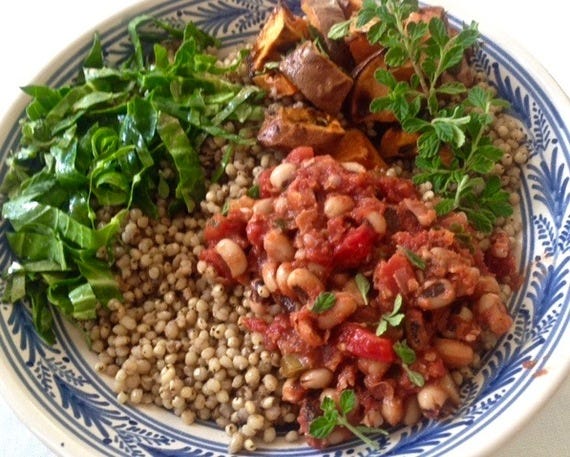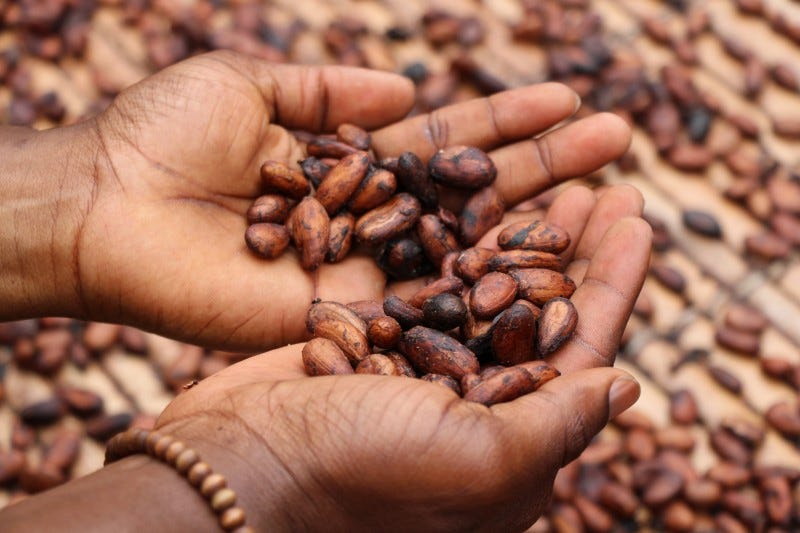Celebrate Africa’s Delicious Gifts with a Juneteenth Bowl
I thought about what recipe I wanted to share for today, Juneteenth, African American Emancipation Day. Yams? Yum. But what about hearty, heat-loving collards? And kunde, Swahili for black-eyed peas? These foods and so many others on our tables come to us from Africa. So I brought many of Africa’s gifts together for one delicious, nutrient-dense Juneteenth Bowl:
sweet potatoes — In America, we confuse yams and sweet potatoes. What came from Africa are yams, true tubers, with rough skins and pale, starchy flesh. Sweet potatoes, root vegetables, are smoother skinned, with soft. orange flesh. Both are sweet, yet low glycemic and high in antioxidants but sweet potatoes grow more plentifully here.
black-eyed peas — Aka kunde, black-eyed peas love Miami’s summer heat and humidity as much as I do. Born to thrive when it’s hot, these beans can also survive the freezer. Cooking up a big pot of these black eyed beauties means enjoying bright summer flavors now and long after your summer tan has faded. Freeze the leftovers then pull your ready-made meal out some miserable night in October when the idea of cooking reduces you to tears.
sorghum — Sorghum, a gluten-free ancient grain, serves as the base of this bowl. Sorghum goes back millennia and was introduced to America over three centuries ago. It’s been a Southern staple crop ever since.
peanuts — Not a true nut, but a legume, a member of the bean and pea family. It’s rich in protein, fiber, and overall deliciousness, and as with other legumes, peanuts enrich the soil they’re grown in.
collards — According to James Beard Award winning food historian Michael Twitty, collards aren’t native to Africa, but they became the mainstay of slaves in the South, who supplemented their diet by growing collards and other hearty, heat-tolerant greens. As he writes, “This food . . . connects us to Africa. It connects us to slavery, to freedom, to sharecropping, to migration, to triumph, to survival. It’s a powerful symbol of our history, our social identity, and the cultural politics we negotiate our lives by.”
Juneteenth Bowl Options and Alternatives
Sorghum is a slow-cooking grain. Really slow. It needs an hour’s worth of simmering or the aid of an Instant Pot for quickest, most tender results. For a quicker fix, use rice, another whole grain with a rich African history.
Peanut allergy? My heart goes out to you. Substitute toasted sunflower seeds or pumpkin seeds. Or both!
Collards can be switched out for other sturdy greens like kale or, if you can get your hands on some, sweet potato greens.
All Juneteenth Bowl components can be made a day or two ahead, then kept covered and refrigerated. Assemble when you’re ready. It’s nutrient-dense, rainbow-bright and flavor-packed. It’s like Juneteenth in a bowl.
Juneteenth Bowl
Any one of the components in my Juneteenth bowl is a delicious way to celebrate Juneteenth, and each can be made in advance. But they’re better together. So are we.
Ingredients
For the sorghum:
4 cups water or vegetable broth
1 cup sorghum
1 tablespoon coconut oil
1 teaspoon cumin
juice of 1 lemon
sea salt and freshly ground pepper to taste
For the sweet potato:
1 sweet potato, chopped
1 tablespoon olive oil
a sprinkle of sea salt
For the collards:
1 bunch collard greens
1 garlic clove, minced
1 tablespoon olive oil
2 tablespoons freshly squeezed lemon juice (from 1 juicy lemon)
sea salt and freshly ground pepper to taste
For black-eyed pea stew:
1 tablespoon olive oil
1 onion, chopped
2 garlic cloves, minced
1/2 jalapeno, minced
1 red pepper, chopped
1 stalk celery, chopped
2 cups black-eyed peas, cooked and cooled
1 28-ounce can chopped fire-roasted tomatoes, or about 2 pounds fresh ripe tomatoes (2-3 good-sized tomatoes) chopped
2 teaspoons paprika
1/2 teaspoon turmeric
1 sprig fresh thyme leaves
1/2 teaspoon sorghum syrup or molasses
sea salt and freshly ground pepper to taste
To serve:
1/2 cup roasted peanuts, chopped
Instructions
Preheat oven to 425 degrees.
Bring water or vegetable broth to boil in a large pot. Add sorghum. Keep the pot on high heat and continue boiling for another 5 minutes. Then reduce the heat to low, cover the pod and let everything simmer for 1 hour. It will need little attention, just peek in occasionally and give it a stir so the sorghum doesn’t get lonely and there’s still plenty of liquid in the pot.
After an hour, grains should be tender and plump. Pour off any liquid the grains haven’t absorbed. Toss sorghum with coconut oil, cumin and lemon juice. Season generously with sea salt and freshly ground pepper.
Meanwhile, spread chopped sweet potato onto a rimmed baking sheet. Drizzle with 1 tablespoon of the olive oil and sprinkle with a little sea salt.
Roast sweet potato in the oven for 30 minutes, stirring occasionally to prevent charring. When sweet potato is tender and darkened at the edges, remove from oven and set aside.
In a good-sized soup pot, heat the remaining tablespoon of olive oil over medium-high heat. When it starts to shimmer, add the chopped onion. Stir and cook for a few minutes, until onion starts to turn translucent. Then add minced garlic and jalapeno, chopped red pepper and celery. Stir and cook for 8 to 10 minutes, or until vegetables soften and become fragrant.
Stir in the cooked black-eyed peas, the chopped tomatoes, paprika and turmeric. Cover and simmer for 20 to 30 minutes.
Remove the lid and add the sorghum syrup or molasses to balance flavors. Add fresh thyme leaves and season to taste with sea salt and pepper.
Wash the collards well. Blot dry. Slice out the thick central stems, reserve them for broth or compost. Stack the collard leaves and roll them up widthwise, forming a tight collard cigar. Using your sharpest knife, slice across as thinly as possible, forming skinny ribbons — collard tinsel — or to use the proper culinary term, chiffonade. Alternately, using the shredding disc, shred the collards in a food processor. You’ll have roughly 2 cups of greens.
Scoop the collards into a large bowl. Add the minced garlic, lemon juice and olive oil. Toss to combine. Season with sea salt and pepper.
To serve, scatter a spoon or two of collards into bowls. Spoon sorghum to cover. Top with chopped sweet potato, a few more shreds of collards and a good ladle or two of black-eyed peas. Sprinkle with chopped peanuts and enjoy.
Looking for a printable version of this recipe? Grab it here.
More Africa-Inspired Recipes I Love
Sweet potatoes, peanuts and black-eyed peas come together again in my recipe for African American sweet potato and peanut stew, from my book, Feeding the Hungry Ghost: Life, Faith and What to Eat for Dinner.
Sukuma wiki, Swahili for stretch the week is a celebration of greens (and your solution to summer green overage).
Chef Tanya Holland shares a recipe for black-eyed pea dip from her new book, Tanya Holland’s California Soul.
Mafé, a luscious Senegalese stew of sweet potatoes, peanuts and okra from La Cocina’s Nafy Flatley.
Finish sweet with my recipe for red velvet cake, which gets its natural redness, sweetness and tenderness from a beet.
For more of African cuisine and culture, check out the wonderful Netflix series High on the Hog.
Thank you for reading! This issue of Broccoli Rising is free so please feel free to share.
Beginning later this summer, special events, interviews and interactive fun will be coming to my paid subscribers.
You can also visit SoulfulVegan.com to find more recipes and connect with me online at YouTube, Instagram, Twitter and Substack Notes.
Join me for my cooking class Cheap Eats for Tough Times happening 6pm ET Thursday, July 6. It’s free, virtual and open to the public, hosted by the Edison branch of Miami Dade Public Library. Link to register coming soon.














